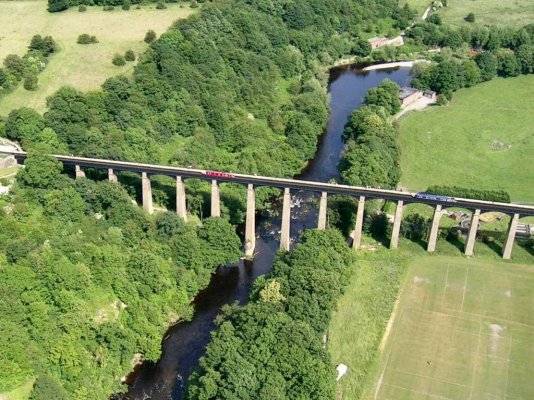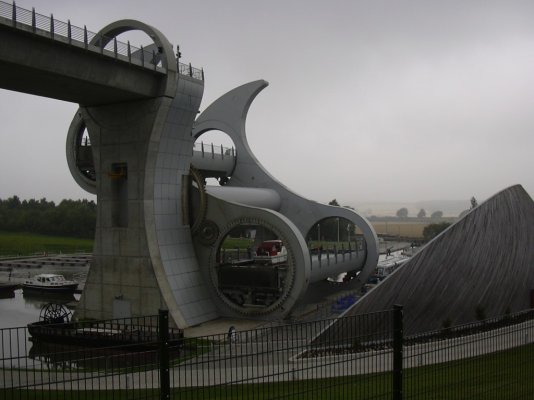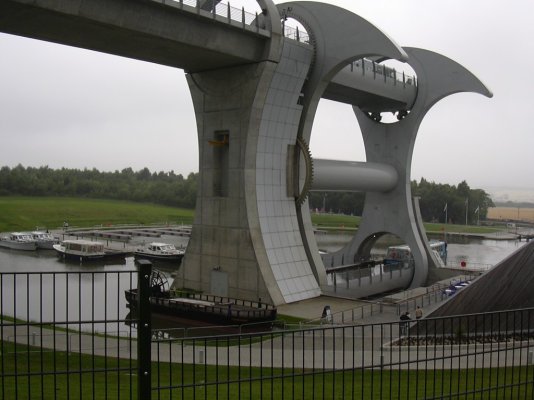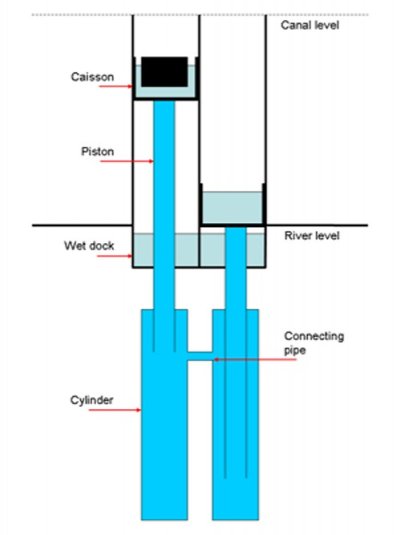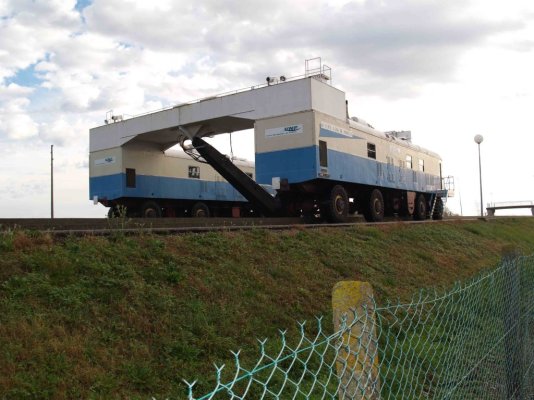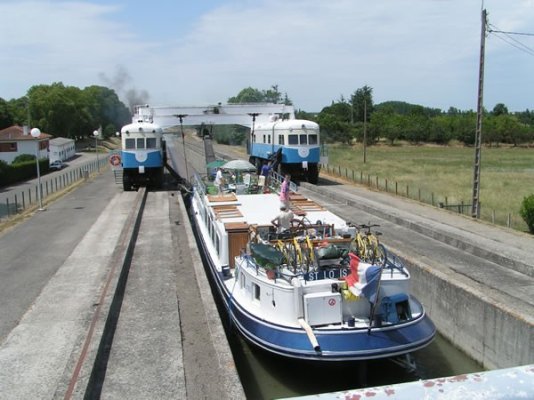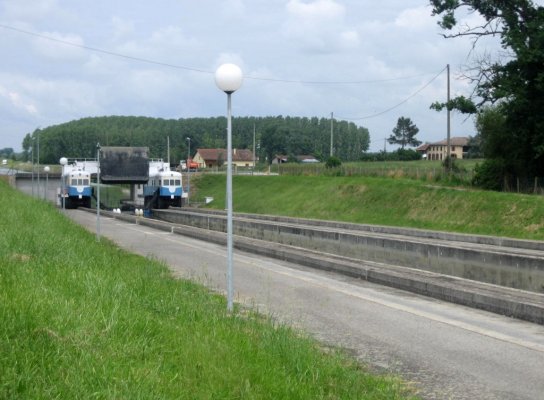You are using an out of date browser. It may not display this or other websites correctly.
You should upgrade or use an alternative browser.
You should upgrade or use an alternative browser.
Water Bridge
- Thread starter KJ
- Start date
The friendliest place on the web for anyone who enjoys boating.
If you have answers, please help by responding to the unanswered posts.
If you have answers, please help by responding to the unanswered posts.
dwhatty
Moderator Emeritus
- Joined
- Sep 25, 2008
- Messages
- 2,846
- Location
- USA
- Vessel Name
- "Emily Anne"
- Vessel Make
- 2001 Island Gypsy 32 Europa (Hull #146)
You gotta love engineers playing around with water. They can produce some cool things.
While not a water bridge (more of a canal lock), someone (Marin?) once posted on the Falkirk Wheel.
*
[video=[MEDIA=youtube]n61KUGDWz2A[/MEDIA]]
*
*
*
*
While not a water bridge (more of a canal lock), someone (Marin?) once posted on the Falkirk Wheel.
*
[video=[MEDIA=youtube]n61KUGDWz2A[/MEDIA]]
*
*
*
*
That's all modern stuff.* HERE's a water bridge* It's*the Pontcysyllte Aquaduct in Wales and it carries the Llangollen Canal across the River Dee.* Designed by Thomas Telford, construction began in 1795 and it opened for traffic ten years later. It is still in use today*with its original construction--- we've been across it several times.
*
-- Edited by Marin on Tuesday 21st of February 2012 06:15:58 PM
*
-- Edited by Marin on Tuesday 21st of February 2012 06:15:58 PM
Attachments
dwhatty
Moderator Emeritus
- Joined
- Sep 25, 2008
- Messages
- 2,846
- Location
- USA
- Vessel Name
- "Emily Anne"
- Vessel Make
- 2001 Island Gypsy 32 Europa (Hull #146)
Is that a two lane canal? If not, hope those barges are headed in the same direction!Marin wrote:
That's all modern stuff.* HERE's a water bridge* It's*the Pontcysyllte Aquaduct in Wales and it carries the Llangollen Canal across the River Dee.* Designed by Thomas Telford, construction began in 1795 and it opened for traffic ten years later. It is still in use today*with its original construction--- we've been across it several times.
*
-- Edited by Marin on Tuesday 21st of February 2012 06:15:58 PM
weebobby
Veteran Member
- Joined
- Feb 16, 2011
- Messages
- 88
- Location
- Canada
- Vessel Name
- Painters Cove
- Vessel Make
- 1997 Bayliner 5788
The Falkirk Wheel connects the Forth and Clyde canal to the Union canal and replaces a flight of 11 locks that were closed and filled in the 1930's.
The Union canal is a "contour canal" and other than the lift from the *Falkirk wheel, it has no locks, *but follows the contour of the land. It does however have several aqueducts similar to the one in Marin's picture, these were built around 1830 or so.
Apropos of nothing, my grandfather (the original Wee Bobby) was the lockeeper at lock 16 , a mile from the current Falkirk wheel , for many years and I have fond memories of "helping him" open and close the lock gates and crank open the road bridge by hand around 1947 thru the early 1950's when I was just a wee laddie.
-- Edited by weebobby on Tuesday 21st of February 2012 10:03:25 PM
The Union canal is a "contour canal" and other than the lift from the *Falkirk wheel, it has no locks, *but follows the contour of the land. It does however have several aqueducts similar to the one in Marin's picture, these were built around 1830 or so.
Apropos of nothing, my grandfather (the original Wee Bobby) was the lockeeper at lock 16 , a mile from the current Falkirk wheel , for many years and I have fond memories of "helping him" open and close the lock gates and crank open the road bridge by hand around 1947 thru the early 1950's when I was just a wee laddie.
-- Edited by weebobby on Tuesday 21st of February 2012 10:03:25 PM
markpierce
Master and Commander
- Joined
- Sep 25, 2010
- Messages
- 12,557
- Location
- USA
- Vessel Name
- Carquinez Coot
- Vessel Make
- penultimate Seahorse Marine Coot hull #6
That's totally weird.* What's the cost?* A thousand Euro a cycle?* If not, it would seem others are subsidizing the boaters.
weebobby
Veteran Member
- Joined
- Feb 16, 2011
- Messages
- 88
- Location
- Canada
- Vessel Name
- Painters Cove
- Vessel Make
- 1997 Bayliner 5788
*The Forth and Clyde canal and the Union canal between them total 67 miles. The 35 miles of the Forth and Clyde canal has 39 locks and the Union canal has the Falkirk Wheel plus one other nearby lock.markpierce wrote:
That's totally weird.* What's the cost?* A thousand Euro a cycle?* If not, it would seem others are subsidizing the boaters.
Boaters pay a licence fee for a set number of days* unlimited transit, for example a 14 day licence to cover both canals is approximately $750 US
Is that a two lane canal? If not, hope those barges are headed in the same direction!dwhatty wrote:Marin wrote:
It's*the Pontcysyllte Aquaduct in Wales and it carries the Llangollen Canal across the River Dee.***
*No, the Pontcysyllte is one narrowboat wide.* The trough itself is made of cast iron (and it's held up just fine*since the 1790s when it was made).
It's been a few years since we've gone across it so I don't know if the traffic management system has changed any since then.* But the way it worked when we went across was the way it worked when the canal opened in 1805.* If you get to the aquaduct and there is a boat coming across in your direction you wait until it has cleared your end.* If there is no boat coming in your direction you proceed onto the aquaduct.* Any boats arriving at the other end have to wait for you to clear their end.
The canal can get quite busy in the summer but unless they have initiated some sort of traffic scheme it all relies on common sense and courtesy.* If you arrive at the aquaduct and there is already a boat going the same way you are, if you don't see a waiting boat at the other end you can procede behind the boat ahead of you.* If you get to the aquaduct and there is boat ahead of you going your way but you see a waiting boat at the other end, you wait until the boat ahead of you has cleared and the waiting boat has come across before you head onto the aquaduct. From our experience it all seems to work just fine.
Something they learned on earlier "trough" aquaducts is incorporated into this one.* Fortunately, they didn't have to learn it on this one after it was completed.* On an earlier, much shorter aquaduct they made the trough just a few inches wider than the boat. The trough, like the locks, was seven feet wide.* The beam of a narrowboat varies from 6' 2" to 6' 8" or so.* And of course, until the very end of the 1800s the boats were all horse-drawn.
So the first time they tried taking a narrow boat across this shorter aquaduct the horse couldn't do it.* The problem, they quickly realized, is that the boat pushed water ahead of it, but with no place for the water to go the resistance became too much for the horse to overcome.* The solution was to rework the trough so the towpath was actually a strong shelf cantilevered out over the water.* The boat ran between the inside edge of the towpath and the opposite side of the trough.* This gave the water an escape route back alongside the boat under the towpath.* The water resistance disappeared and the horse had no problems pulling one or often two narrowboats across.
If you look at the photo below, you will see the cantilevered towpath on the far side of the trough.*
If I remember right the Pontcysyllte is 126 feet high over the river and is 1,000 feet long.* On the non-towpath side there is nothing between you and the sheep grazing in the pastures below except that five foot high wall of cast iron that was forged in 1798 or thereabout.
*
-- Edited by Marin on Wednesday 22nd of February 2012 04:20:39 AM
Attachments
Mark
The engineering of the wheel allows it to turn on roughly the amount of energy it takes to make your morning coffee - or so their brochure says. Once you get it moving, it takes almost no energy to keep it moving, so all the energy cost is in starting and stopping. Don't forget about the second lock balancing the first. They both weigh the same, so as long as there isn't a source of friction, you could turn the wheel with a hand crank.
The engineering of the wheel allows it to turn on roughly the amount of energy it takes to make your morning coffee - or so their brochure says. Once you get it moving, it takes almost no energy to keep it moving, so all the energy cost is in starting and stopping. Don't forget about the second lock balancing the first. They both weigh the same, so as long as there isn't a source of friction, you could turn the wheel with a hand crank.
*The two chambers of the wheel balance each other out.* It takes very little actual power to turn it.markpierce wrote:
That's totally weird.* What's the cost?* A thousand Euro a cycle?* If not, it would seem others are subsidizing the boaters.
Here's another engineering marvel on the water.* Called the Anderton Lift, it was constructed in 1875 to move narrowboats between the Trent & Mersey canal and the River Weaver some fifty feet below.* It, too, uses the principle of two chambers that weigh the same so require very little power to move them.* One goes up as one goes down.
Initially powered hydraulically (with water), when the big hydraulic pistons under each chamber corroded to the point where they were no longer serviceable the lift was converted to electric power.* Hence all the wheels and cables on top of the lift.
Today the lift has been restored to working order using a new set of hydraulic cylinders and the electric system has been deactivated.* However the mechanical components of the electric system have been left in place so people can see how it worked.* The lift is in daily use today.
A steam engine was used to power the original hydraulic system, and it requred an engine of just ten horsepower to operate it.
Attachments
markpierce
Master and Commander
- Joined
- Sep 25, 2010
- Messages
- 12,557
- Location
- USA
- Vessel Name
- Carquinez Coot
- Vessel Make
- penultimate Seahorse Marine Coot hull #6
I was thinking of the cost amortization of construction, mostly. And maintenance.* Yes, the energy for its operation would be minor, much like a counter-weighted lift bridge.
-- Edited by markpierce on Wednesday 22nd of February 2012 03:55:23 PM
-- Edited by markpierce on Wednesday 22nd of February 2012 03:55:23 PM
There is not enough money in the world to get me to go across the water bridge posted by Marin, or the bucket lifts in Canada.
By* the way, yet another great picture posted by Marin. I don't know if it's his or one he found, but it's still a great picture. Thanks.
Good for those of you who do the locks and lifts, but I'm afraid of heights, and I'll stick to sea level. The Great Bridge lock at Great Bridge VA, is the most I can handle.
And most of the time it just keeps seawater from the fresh water canal.
Mike
Palm Coast FL
By* the way, yet another great picture posted by Marin. I don't know if it's his or one he found, but it's still a great picture. Thanks.
Good for those of you who do the locks and lifts, but I'm afraid of heights, and I'll stick to sea level. The Great Bridge lock at Great Bridge VA, is the most I can handle.
And most of the time it just keeps seawater from the fresh water canal.
Mike
Palm Coast FL
I did not take the photos of the Anderton Lift although we've been there several times over the years.* The photos are off the web.Mike wrote:
There is not enough money in the world to get me to go across the water bridge posted by Marin, or the bucket lifts in Canada.
By* the way, yet another great picture posted by Marin. I don't know if it's his or one he found, but it's still a great picture. Thanks.
So if you don't like heights, here's something that could work for you.* Again, we've been here and I've taken photos but these are not them.* These are off the web.
This is the inclined plane or water slope at Montech on the Canal du Midi in southcentral France.* It was constructed in 1974 to bypass five conventional locks that parallel it.
The principle is interesting.* The two rubber-tired diesel-hydraulic locomotives have a big lift gate between them in front.* A bit like*bulldozer blade if you will.* The sides and bottom of this gate have rubber skirts that seal up against the smooth concrete sides of the long inclined trough.
When the locmotives are parked at the bottom of the slope, the canal water extends into the trough far enough to drive a boat in between the locomotives and into the trough ahead of the gate.* The gate then comes down and creates a dam.* The locomotives then start up* the guideway flanking the trough and the gate or dam pushes the water with the boat floating in it up to the top until the water in front of the blade is the same depth as the water in the canal, which is being held back by a set of doors.* When evrything has "evened out" the doors open and the boat chugs out into the canal.
Going down the process is sort of reversed.* The locomotives are positioned a boat length or so downslope of the upper doors and the gate/dam/blade is lowered to seal off the trough.* Water from the canal is let in until the level in front of the locomotives' gate is the same as the level of the canal above.* The doors are then opened and the boat enters the "chamber" formed by the locomotive's gate and the sides of the trough.* The doors are then closed to prevent the canal water from flowing down the trough.*
The locomotives then*back down the guideway and the "slug" of water with the boat in it comes along with them.* At the bottom, the locomotives stop so the canal water behind (downstream of) the blade is the same depth as the water in front of the gate.* When it's all evened out, the gate is raised and the boat chugs out between the locomotives into the canal.
According to my good friend who lives in this area the waterslope works as advertised but did not prove to be as efficient (fast) as had been hoped.* It is still used today but so are the locks it was meant to replace.
But it's a pretty*clever idea I think.* Someday I'd like to take a boat up or down it.
The first photo shows the gate/dam/blade in the up position so a boat can enter the trough under it.* In the second photo the locomotives are taking a boat down the water slope.* The fourth photo shows the layout with the five original locks on the left and the water slope on the right.
As an interesting side note, the five locks at Montech*are staircase locks, in which the bottom doors of teh chambers are the upper doors of the next chamber down.* They have a few staircase locks in the UK, too, and we know from experience they can be a real challenge to operate.* Not becuase they are physically hard but because they have to be operated in a very specific sequence or disaster is the result.* In France, all the locks are either automatic or have full-time lockkeepers to run them.* In the UK, you're on your own.
*
-- Edited by Marin on Thursday 23rd of February 2012 12:13:20 AM
Attachments
Similar threads
- Replies
- 29
- Views
- 3K

